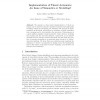Free Online Productivity Tools
i2Speak
i2Symbol
i2OCR
iTex2Img
iWeb2Print
iWeb2Shot
i2Type
iPdf2Split
iPdf2Merge
i2Bopomofo
i2Arabic
i2Style
i2Image
i2PDF
iLatex2Rtf
Sci2ools
FORMATS
2005
Springer
2005
Springer
Implementation of Timed Automata: An Issue of Semantics or Modeling?
Abstract. We examine to what extent implementation of timed automata can be achieved using the standard semantics and appropriate modeling, instead of introducing new semantics. We propose an implementation methodology which allows to transform a timed automaton into a program and to check whether the execution of this program on a given platform satisfies a desired property. This is done by modeling the program and the execution platform, respectively, as an untimed automaton and a collection of timed automata. We also study the problem of property preservation, in particular when moving to a “better” execution platform. We show that some subtleties arise regarding the definition of “better”, in particular for digital clocks. The fundamental issue is that faster clocks result in better “sampling” and therefore can introduce more behaviors.
| Added | 27 Jun 2010 |
| Updated | 27 Jun 2010 |
| Type | Conference |
| Year | 2005 |
| Where | FORMATS |
| Authors | Karine Altisen, Stavros Tripakis |
Comments (0)

